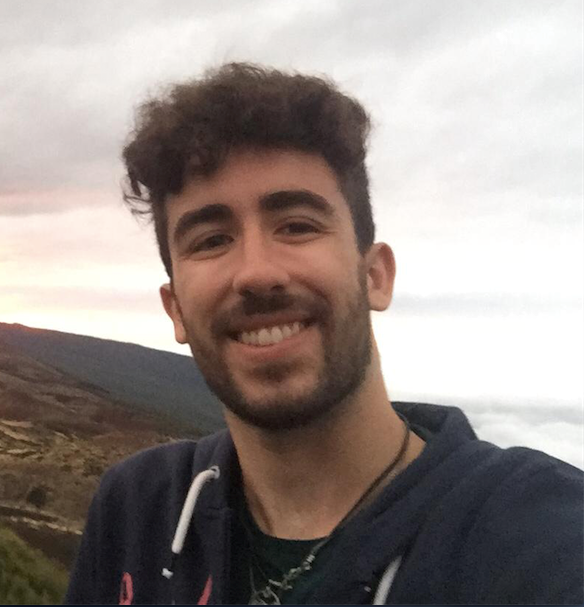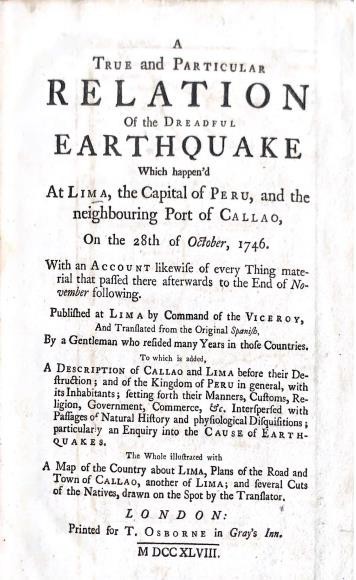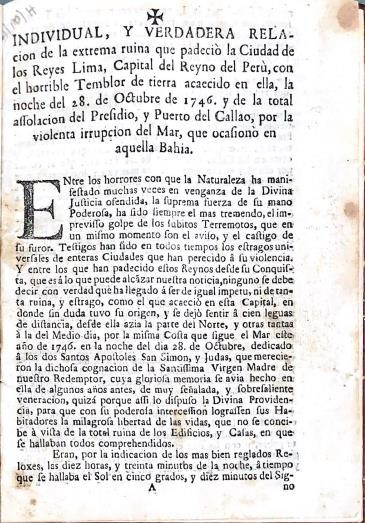Jesús Jiménez Valdés
PhD candidate, Department of Hispanic Languages and Literature
Guiliano Fellow, Fall 2022
 Local archives and imperial Texts: Jorge Juan and Antonio de Ulloa’s scientific writing
in the 18th century
Local archives and imperial Texts: Jorge Juan and Antonio de Ulloa’s scientific writing
in the 18th century
Following in the footsteps of the enlightened traveler Antonio de Ulloa, I delved into the archives of the National Library of Lima. In a chapter of my thesis I investigate the disruptive effects that the scientific expeditions provoked in the heart of the Hispanic American literate city. The Hispanic Monarchy organized a series of expeditions throughout the eighteenth century with the intention of making a true inventory of the social and natural resources of its American possessions. To this end, resources, people, instruments, practices and knowledge were mobilized. Our working hypothesis, therefore, was based on the stay of Ulloa and the various members of the geodesic expedition of 1735, a truly transnational enterprise that toured South America, in the City of the Kings, capital at that time of the immense Viceroyalty of Peru. Although the center of operations was in Quito, different conjunctural episodes required Ulloa's assistance in Lima, requested by the viceroy himself. Among these episodes we can count, for example, the organization of the defense of the South Sea against the English attacks, coinciding with the last years of the expedition. So fruitful was his stay in Lima that he even celebrated his wedding in the Cathedral of the city with a Creole lady of the high society. However, we were more interested in locating documents that would reveal some government commission that had not been brought to light, or perhaps some kind of legal paper that would have given rise to a judicial process.

However, beyond what is already known, we could not confirm any presence of Ulloa, at least in the way we mentioned above. We believe that the success of our search lies in the location of "indirect", lateral documentation, with which we will be able to get a better idea of the literary context, that is, of the printed and intellectual culture of Lima at the time.
The one we want to highlight is a print published in London 1748, the year in which the members of the expedition were organizing their return trip, separately, to Europe. It is a non-serial publication (image 1) that gave an account of the important and devastating earthquake that left most of the city and the port of El Callao in ruins: the earthquake of 1746. Of course, the interest lies not only in the chronicle of the event, but also in the fact that the informant, a supposed merchant "resident in Lima for many years", makes an exhaustive chronicle of the situation of the viceroyalty, something similar to what Ulloa and company proposed supported by the institutions of the Monarchy.
Curiously, it seems that it was also written as a reply to another print published, this time in Spanish, in the same year of the earthquake (image 2). Evidently, in this case the Monarchy is praised and the earthquake is caused by the sins of the bad Spaniards. We would be deceived if we considered this one as a religious text and the English one as a scientific one. Evidently, the Englishman shields himself in science to label the Spanish Americans as ignorant, but agrees in the diagnosis that the evils have been caused by divine design.
The chronicle has no pretensions of objectivity, since it focuses on uncovering the weak points of the kingdom, so that in London they receive the information and act accordingly. The data that are handled come from the report of Father Feuillée, the first European who had royal permission to travel to the viceroyalties as an expeditionary. This would confirm that his texts were handled in the decade of 1740 and, in the absence of confirming a publication of his work in the city, we could count him as Ulloa's own source (during this month we were able to collate the data: data and certain approximations of the author coincide).
Ulloa himself took advantage of his visit to Lima to write his own version of the events that took place after the earthquake. We would have to include in our thesis the comparison of both versions, one at the service of the Hispanic Monarchy and the other at the service of the English Monarchy, enemy powers throughout the 18th century, in fierce competition for the natural resources of America.

Parallel to this print we were able to find another one corresponding to the earthquake, this time published in Portuguese and published in Lisbon in the same year. For a scientific article, the triangulation of Ulloa's chronicle of the Lima earthquake, the English and Portuguese printings, triangulation referring to the data, the positioning of the authors and the underlying interests, would remain pending. Both texts, the Portuguese and the English version, were scanned.
We were also able to consult Ulloa's own texts, published in Spain after 1750 and brought to America in the following years. Different versions of the Viaje a la America Meridional - its four volumes - are in the Library in their original version, all of them consulted. This would prove the important role played by the Lima printing press, and confirm that the viceroyalty, even in a period of supposed decadence, still had considerable intellectual capital and a population eager to receive the latest printed novelties from Europe.
In addition to our archival work, we were able to visit several Huacas or ceremonial centers of pre-Inca cultures. We wanted to attend first hand as Ulloa considered it essential in his narration of the origins of the city to incorporate the indigenous histories subsumed in the Inca story. The Huacas allowed to decipher the cultures that were superimposed in the valley of the Rímac, where finally the Spaniards settled to found the capital of the viceroyalty. We also walked through the places that Ulloa described in the historical center of the city, following the map that he included in his work, as well as the Cathedral where he married. Ulloa always maintained that Lima seemed to him, before the earthquake, one of the most magnificent cities he had ever visited; he, who before his thirties had already traveled almost all of South America, and who would later visit half of Europe. We cannot say something similar, but we do hope that someday it will recover the splendor that, according to Ulloa, it once had.
The Guiliano Global Fellowship Program offers students the opportunity to carry out
research, creative expression and cultural activities for personal development through
traveling outside of their comfort zone.
GRADUATE STUDENT APPLICATION INFORMATION
UNDERGRADUATE STUDENT APPLICATION INFORMATION
Application Deadlines:
Fall deadline: October 1 (Projects will take place during the Winter Session or spring semester)
Spring deadline: March 1 (Projects will take place during the Summer Session or fall semester)
Please submit any questions here.
